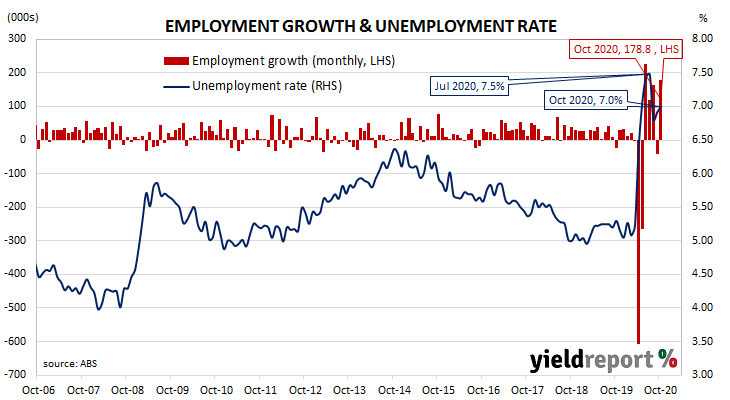Summary: Employment grows in October; September job losses revised up; employment number rises much more than expected; private sector “scaling the fiscal cliff”; national participation rate jumps, close to pre-COVID peak; more people seeking work but larger available workforce sees jobless rate up; part-time, full-time jobs both up substantially; work hours rise over month but still down over year; underemployment rate under 11%.
Australia’s period of falling unemployment came to an end in early 2019 when the jobless rate hit a low of 4.9%. It then averaged around 5.2% through to March 2020, bouncing around in a range from 5.1% to 5.3%. Leading indicators such as ANZ’s Job Ads survey and NAB’s capacity utilisation estimate suggested the unemployment rate would rise in the June quarter and it did. More recent readings suggested the unemployment rate may have peaked. However, the RBA and some economists are still expecting the rate to rise before the end of 2020.
The latest Labour force figures have now been released and they indicate the number of people employed in Australia increased by considerably more than economists had expected. The report showed the total number of people who held a job according to ABS definitions rose by 178,800 in October. The rise was in contrast to September’s 42,500 fall after it was revised from -29,500 and the 30,000 decline which had been generally expected.
“Today’s data add to evidence that the private sector is scaling the fiscal cliff, despite the payroll data signalling some recent weakness,” said ANZ senior economist Catherine Birch.
Domestic Treasury bond yields remained largely unchanged, broadly in line with US Treasury bond movements. By the end of the day, 3-year and 10-year ACGB yields remained unchanged at 0.17% and 0.89% respectively, while the 20-year yield finished 1bp higher at 1.52%.
In the cash futures market, expectations of a change in the actual cash rate, currently at 0.05%, also barely changed. At the end of the day, contract prices implied the cash rate would slip a little closer to zero in December and then settle at around 0.04% through 2021.
The participation rate jumped from September’s revised level of 64.9% to 65.8% as the total available workforce grew by 204,300 to 13,734,800. The number of unemployed persons increased by 25,500 to 960,900; the higher unemployment number outweighed the increase in the number of people in the workforce, leading to the unemployment rate ticking up from 6.9% to 7.0%.

